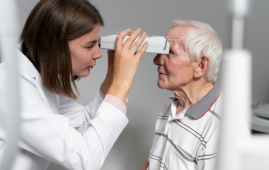

Swallowing the device before a meal may cause a sense of fullness, deceiving the brain into thinking it’s time to quit eating. When you indulge in a hearty meal, intricate signals are dispatched from your stomach to your brain, triggering a sensation of fullness and signaling that it’s time to cease eating. Remarkably, these signals can be equally conveyed by a stomach filled with liquid, underscoring the wisdom behind the common advice for individuals seeking to manage obesity to consume a glass of water before their meals. This practice not only aligns with healthy dietary habits but also capitalizes on the physiological response to promote a sense of satiety, contributing to more mindful and controlled eating.
MIT engineers have developed a novel method for capitalizing on this phenomena, employing an ingestible capsule that vibrates within the stomach. These vibrations trigger the same stretch receptors that detect when the stomach is inflated, giving the illusion of fullness.
The researchers discovered that giving this medication to mice 20 minutes before eating not only promoted the release of hormones that signal satiety, but also lowered the animals’ food intake by roughly 40%. Scientists still have a lot to learn about the mechanisms that control human body weight, but if additional research shows that this technology can be used safely in humans, such a pill could offer a minimally intrusive alternative to treat obesity, according to the researchers.
“It could be taken before each meal for someone who wants to lose weight or control their appetite,” explains Shriya Srinivasan PhD ’20, a former MIT graduate student and postdoc who is now an assistant professor of bioengineering at Harvard University. “This could be really interesting in that it would provide an option that could minimize the side effects that we see with the other pharmacological treatments out there.”
Srinivasan is the study’s primary author, and it was published today in Science Advances. The paper’s senior author is Giovanni Traverso, an associate professor of mechanical engineering at MIT and a gastroenterologist at Brigham and Women’s Hospital.
A sense of completeness
When the stomach stretches, specialized cells known as mechanoreceptors detect it and send signals to the brain via the vagus nerve. As a result, the brain increases the synthesis of insulin as well as other hormones like C-peptide, Pyy, and GLP-1. All of these hormones act together to aid digestion, feeling full, and stopping eating. At the same time, ghrelin, a hunger-promoting hormone, decreases.
Srinivasan became interested in managing this process as a graduate student at MIT by artificially extending the mechanoreceptors that border the stomach with vibration. Previous studies had demonstrated that applying vibration to a muscle might create the illusion that the muscle has stretched further than it actually has.
“I wondered if we could activate stretch receptors in the stomach by vibrating them and having them perceive that the entire stomach has been expanded, to create an illusory sense of distension that could modulate hormones and eating patterns,” Srinivasan said.
As a postdoc at MIT’s Koch Institute for Integrative Cancer Research, Srinivasan collaborated closely with Traverso’s lab, which has pioneered numerous unique techniques to drug and electronic device administration. Srinivasan, Traverso, and their colleagues created a capsule the size of a multivitamin that contains a vibrating element for their study. When the pill, which is powered by a small silver oxide battery, enters the stomach, acidic gastric juices breakdown the capsule’s gelatinous membrane, completing the electronic circuit that activates the vibrating motor.
In an animal investigation, the researchers discovered that when the pill begins to vibrate, it triggers mechanoreceptors, which convey messages to the brain via vagus nerve stimulation. The researchers monitored hormone levels while the gadget was vibrating and discovered that they resembled hormone release patterns seen after a meal, even when the animals had fasted.
The researchers next examined how this stimulation affected the rats’ appetites. They discovered that when the pill was active for roughly 20 minutes before the animals were given food, they devoured 40% less on average than when it was not activated. The animals also acquired weight at a slower rate when they were given the vibrating pill.
“The behavioral change is profound, and this is achieved through the use of the endogenous system rather than any exogenous therapeutic.” “By modulating the enteric nervous system, we have the potential to overcome some of the challenges and costs associated with biologic drug delivery,” Traverso says.
The current version of the pill is meant to vibrate for about 30 minutes after it enters the stomach, but the researchers intend to investigate the idea of modifying it to stay in the stomach for longer periods of time, where it may be turned on and off wirelessly as needed. The pills moved through the digestive tract of the animals in four or five days.
The animals also showed no evidence of obstruction, perforation, or other unfavorable effects while the pill was in their digestive tract, according to the study.
A different approach
According to the researchers, this form of drug could provide an alternative to current techniques to treating obesity. Nonmedical therapies such as nutrition and exercise are not always effective, and many present medical interventions are somewhat invasive. Gastric bypass surgery and gastric balloons, which are no longer routinely utilized in the United States due to safety concerns, are examples.
Drugs such as GLP-1 agonists can also help with weight loss, but the majority of them must be administered and are therefore out of reach for many individuals. According to Srinivasan, the MIT capsules may be produced at a low enough cost that they would be accessible to people who do not have access to more expensive treatment choices.
“Some of the more effective obesity therapies are very expensive for many populations.” “At scale, our device could be manufactured at a fairly low cost,” she explains. “I’d love to see how this would transform care and therapy for people in global health settings who may not have access to some of the more sophisticated or expensive options that are available today.”
The researchers will now look into ways to scale up capsule production, which could lead to human clinical trials. Such research would be necessary to understand more about the safety of the devices, as well as to establish the optimal time to ingest the capsule before a meal and how frequently it would need to be administered.
more recommended stories
 Antioxidants: Impact on Quality of Life in Acne Vulgaris
Antioxidants: Impact on Quality of Life in Acne VulgarisA recent study published in the.
 Brain Pulsations Linked to High BMI
Brain Pulsations Linked to High BMIAccording to a new study from.
 Brain Age Estimation: EEG Advancements in Neurology
Brain Age Estimation: EEG Advancements in NeurologyTo estimate brain age using EEG.
 Retinal Neurodegeneration in Parkinson’s Disease
Retinal Neurodegeneration in Parkinson’s DiseaseBy measuring the thickness of the.
 Role of Engineered Peptides in Cancer Immunotherapy
Role of Engineered Peptides in Cancer ImmunotherapyIn a recent publication in Nature.
 Neoadjuvant Chemotherapy Boosts Ovarian Cancer
Neoadjuvant Chemotherapy Boosts Ovarian CancerDuring the COVID-19 pandemic, US women.
 Nutrient Optimization: Vitamin D for Health
Nutrient Optimization: Vitamin D for HealthResearchers addressed the prevalence of vitamin.
 AD and Headache Disorders: Recent Findings
AD and Headache Disorders: Recent FindingsAtopic dermatitis (AD) patients may be.
 Myasthenia Gravis Treatment: Eculizumab & Ravulizumab
Myasthenia Gravis Treatment: Eculizumab & RavulizumabA recent study found that myasthenia.
 Eosinophilic Asthma Treatment: FDA Approves Benralizumab
Eosinophilic Asthma Treatment: FDA Approves BenralizumabAccording to a news release from.

Leave a Comment